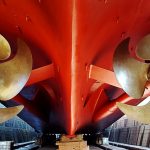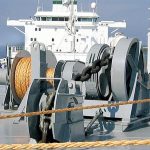
The operation of a vessel out in the untamed seas is a very multifaceted activity since it’s solely carried out at the mercy of Mother Nature. Efficient work patterns are to be followed by the crew not only out at the sea but also at port while anchorage to minimize the outlook of humanoid error, reducing the overall risk of damage to the vessel or cargo on-board.
Seldom, one may consider the time at anchorage to be a time to fall back and rest. Whereas the truth is, the crew might have to be extra cautious and vigilant owing to the weather, meteorological, tidal conditions and traffic around the place where the ship is anchored as the situation may become troublesome and go south anytime.
Responsibilities of A Deck Officer, When The Ship Is At Anchorage
Below mentioned are some of the most important responsibilities of a deck officer, when the ship is at anchorage:Table Of Contents
- Watchkeeping
- Calculation of Swinging Circle
- Displaying Appropriate Lights & Sound
- Constant VHF (Very High Frequency) Watch
- Watching The Machineries
- Constant Weather Report Updates
- Piracy
1. Watchkeeping
The Officer in-charge onboard, need to follow the master’s standing orders, since the master puts faith in the work of the officer and expects the officer to carry out the necessary actions and ensure that a proper lookout is maintained. The position of the ship should be constantly checked and plotted at frequent intervals to ensure that the ship remains securely at the anchor. If due to any bad weather conditions visibility is at stake the master should be notified immediately.
2. Calculation of Swinging Circle
It is primarily important to get an idea of the Swinging Circle, the vessel might incur. After anchoring, it is the duty of the Officer of Watch, to ensure that the ship remains within it’s Swinging Circle, and that no other vessels anchor within the ships’ Swinging Circle. The Swinging Circle varies with the change in tidal levels and the weather.
Calculation:
Swinging Circle = Length of Ship In Meters (Bridge GPS Antenna to FWD) + Number of Shackles x 27.5 m
Swing Radius = L.O.A + [ ( RODE ) 2 – ( DEPTH + FREEBOARD)2 ]½
L.O.A is the overall length of the vessel.
RODE is the length (line to the anchor) of the rode from the bow pulpit to the anchor.
DEPTH signifies water depth over the anchor.
FREEBOARD is the distance from the deck at the bow pulpit to the water.
3. Displaying Appropriate Lights & Sound
The ship should exhibit appropriate flag and sound signals and should switch to appropriate lights in accordance to all regulations.
A vessel at anchor must exhibit an all-round white light in the fore part or at a lower level near the stern. A vessel less than 50 meters in length may exhibit an all-around white light so that other vessels in the same area do not anchor in close proximity to avoid contact in case dragging occurs.
4. Constant VHF (Very High Frequency) Watch
A constant VHF (Very high Frequency) watch should be kept with the coast authorities in case they broadcast any information that might include wreckages, traffic, ETA to pilot, vessel importance and more which might be of vital importance to the safety of the ship.
Incase of dragging or another vessel coming too close to your own, the officer on watch should get their attention either with the help of the VHF or by flashing the Aldis/ Morse lamp so that any kind of collision can be prevented. ECDIS (Electronic Chart Display Information System) updates should be followed closely for traffic updates around the vessel.
5. Watching The Machineries
Master should ensure that the main engines including the other machinery should be ready for operation in accordance with his instructions. Additionally, strict measures should be taken to protect the environment from pollution by the ship or any of its cargo and comply with pollution regulations.
6. Constant Weather Report Updates
Weather Reports, meteorological and tidal movements should be taken into consideration to predict the state of the sea so that the ship doesn’t move catering to these conditions. The Swinging circle or the radius around which the ship might move about should be calculated and precautions should be taken so that the vessel does not make contact with other solid objects around, be it marine traffic or rocks in the sea bed.
7. Piracy
If the ship is anchored in areas prone to piracy, it is of vital importance that the crew and the officer on watch is on high alert all the time because anchorage of the ship can make it fairly easy for pirates to board and hijack the ship.
These were the seven important responsibilities of deck officers, while their ship is anchored!


Comments are closed